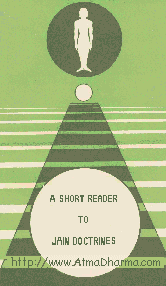

A Short Reader to Jain Doctrines (Principles)
(English version of 'Laghu Jain Siddhant Praveshika'
written by Pandit Gopaldasji Baraiya)
Translator
Br. Hemchand Jain, 'HEM'
D.M.E..D.T.Ed
Senior Design Engineer
Steam Turbine Engineering Division
Bharat Heavy Electricals Ltd., Bhopal (India)
Publisher
Pandit Todarmal Smarak Trust
A-4, Bapu Nagar, Jaipur 302015 (India)
 .
.
 and
and
 the work or any function,
due to its being exactly as per the cause, is always exactly identical to
its (substantive) cause. The work is also known as action, deed,
the work or any function,
due to its being exactly as per the cause, is always exactly identical to
its (substantive) cause. The work is also known as action, deed,  (Nyaya Deepika, Page 17)
(Nyaya Deepika, Page 17)
 i.e., comprehending (an object) in two ways contrary to each other
such as 'it is this way or it is that way' is called 'doubt'. For example
I am soul or body ?
i.e., comprehending (an object) in two ways contrary to each other
such as 'it is this way or it is that way' is called 'doubt'. For example
I am soul or body ?
 i.e., comprehending (an object) contrary to the intrinsic nature
of that
i.e., comprehending (an object) contrary to the intrinsic nature
of that  i.e., comprehending (an object) without (its) certainty, such as 'something
is there' is called 'indecisiveness'. For example - I am something.
i.e., comprehending (an object) without (its) certainty, such as 'something
is there' is called 'indecisiveness'. For example - I am something.